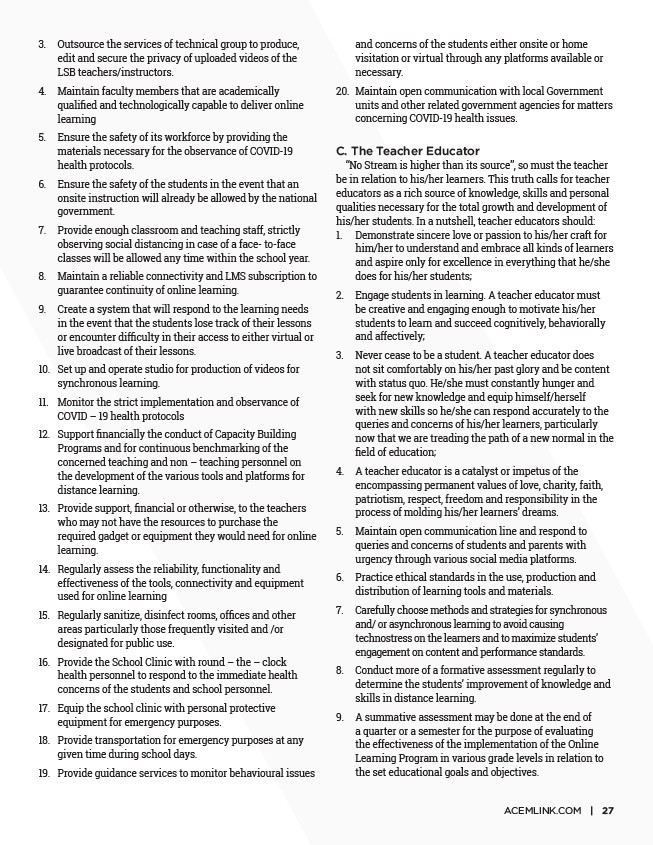
3. Outsource the services of technical group to produce,
edit and secure the privacy of uploaded videos of the
LSB teachers/instructors.
4. Maintain faculty members that are academically
qualified and technologically capable to deliver online
learning
5. Ensure the safety of its workforce by providing the
materials necessary for the observance of COVID-19
health protocols.
6. Ensure the safety of the students in the event that an
onsite instruction will already be allowed by the national
government.
7. Provide enough classroom and teaching staff, strictly
observing social distancing in case of a face- to-face
classes will be allowed any time within the school year.
8. Maintain a reliable connectivity and LMS subscription to
guarantee continuity of online learning.
9. Create a system that will respond to the learning needs
in the event that the students lose track of their lessons
or encounter difficulty in their access to either virtual or
live broadcast of their lessons.
10. Set up and operate studio for production of videos for
synchronous learning.
11. Monitor the strict implementation and observance of
COVID – 19 health protocols
12. Support financially the conduct of Capacity Building
Programs and for continuous benchmarking of the
concerned teaching and non – teaching personnel on
the development of the various tools and platforms for
distance learning.
13. Provide support, financial or otherwise, to the teachers
who may not have the resources to purchase the
required gadget or equipment they would need for online
learning.
14. Regularly assess the reliability, functionality and
effectiveness of the tools, connectivity and equipment
used for online learning
15. Regularly sanitize, disinfect rooms, offices and other
areas particularly those frequently visited and /or
designated for public use.
16. Provide the School Clinic with round – the – clock
health personnel to respond to the immediate health
concerns of the students and school personnel.
17. Equip the school clinic with personal protective
equipment for emergency purposes.
18. Provide transportation for emergency purposes at any
given time during school days.
19. Provide guidance services to monitor behavioural issues
and concerns of the students either onsite or home
visitation or virtual through any platforms available or
necessary.
20. Maintain open communication with local Government
units and other related government agencies for matters
concerning COVID-19 health issues.
C. The Teacher Educator
“No Stream is higher than its source”, so must the teacher
be in relation to his/her learners. This truth calls for teacher
educators as a rich source of knowledge, skills and personal
qualities necessary for the total growth and development of
his/her students. In a nutshell, teacher educators should:
1. Demonstrate sincere love or passion to his/her craft for
him/her to understand and embrace all kinds of learners
and aspire only for excellence in everything that he/she
does for his/her students;
2. Engage students in learning. A teacher educator must
be creative and engaging enough to motivate his/her
students to learn and succeed cognitively, behaviorally
and affectively;
3. Never cease to be a student. A teacher educator does
not sit comfortably on his/her past glory and be content
with status quo. He/she must constantly hunger and
seek for new knowledge and equip himself/herself
with new skills so he/she can respond accurately to the
queries and concerns of his/her learners, particularly
now that we are treading the path of a new normal in the
field of education;
4. A teacher educator is a catalyst or impetus of the
encompassing permanent values of love, charity, faith,
patriotism, respect, freedom and responsibility in the
process of molding his/her learners’ dreams.
5. Maintain open communication line and respond to
queries and concerns of students and parents with
urgency through various social media platforms.
6. Practice ethical standards in the use, production and
distribution of learning tools and materials.
7. Carefully choose methods and strategies for synchronous
and/ or asynchronous learning to avoid causing
technostress on the learners and to maximize students’
engagement on content and performance standards.
8. Conduct more of a formative assessment regularly to
determine the students’ improvement of knowledge and
skills in distance learning.
9. A summative assessment may be done at the end of
a quarter or a semester for the purpose of evaluating
the effectiveness of the implementation of the Online
Learning Program in various grade levels in relation to
the set educational goals and objectives.
ACEMLINK.COM | 27